
16 |
Text by Ferdy de Moor |
|---|---|
Caddisflies
Order Trichoptera
Adults resemble small, drab, grey moths, varying in size from minute (wingspans of <3mm) to large (wingspans approaching 100mm). Some species have striking colours and wing patterns. Wings held over the body in roof-like fashion when at rest, and covered with fine hairs, distinguishing caddisflies from their closest relatives, the Lepidoptera, whose wings are covered with scales. Trichoptera adults have prominent, and sometimes very long, antennae (up to twice the length of the forewing). Adults rest on vegetation near streams and are frequently found under bridges or overhanging trees and rock formations during the day, their active flying period being mainly at dawn or dusk. To find mates, some species form swarms, consisting mostly of males waiting to attract females, while others make use of chemical attraction. Adults feed on nectar and drink water and can live from two weeks to about two months.
Larvae, which represent the longest-living phase of the life cycle (of up to two years), are all aquatic and show a great diversity of adaptations for life in freshwater ecosystems. They use their labial silk glands to construct portable cases or fixed shelters as well as meshed nets for capturing prey or lining burrows. They frequently add sand grains and stones or bits of bark, twigs, leaves and other plant matter to their cases and shelters to provide camouflage and ballast or buoyancy. These adaptations have made them one of the most successful freshwater groups globally. Diagnostic features of caddisfly larvae are the presence of a fully sclerotised (hardened) head, three pairs of segmented thoracic legs and a pair of terminal abdominal anal prolegs (additional ‘false legs’) with claws. With 14,548 species worldwide, they are the largest order of aquatic insects. In southern Africa 19 families, 54 genera and 230 species have been recorded, but it is estimated that well over 300 species occur in the region. Tibial spur formula of adults is used to distinguish families – the formula indicates the number of spurs on the tibia (second long segment of leg, leading to the tarsus or ‘foot’) of the fore-, mid- and hindlegs.
1 Saddle (tortoiseshell) case makers
Family Glossosomatidae


© F. DE MOOR

© W. MCILLERON
Adults small, wings and body brown with golden hairs, ocelli present, tibial spur formula 2, 4, 4. Larvae (1) construct distinctive cases from large sand grains, with openings at both ends, allowing head and anal prolegs to extrude. Have paired sclerotised (hardened) plates on first two thoracic segments, as shown in the larva of Agapetus murinus (1a). Size: Wingspan 7–9mm, mature larvae 3.5–4mm in length. Biology: Larvae classed as ‘scrapers’, feeding on algal and microbial growth on upper and exposed sides of stones in clear mountain streams. Two species known from southern Africa.
2 Micro-caddisflies (purse case makers)
Family Hydroptilidae


© W. MCILLERON

© W. MCILLERON

© F. DE MOOR

© F. DE MOOR

© F. DE MOOR

© F. DE MOOR

© F. DE MOOR
Adults minute with narrow, tapering, grey-brown wings and long fringes of hair on hindwings, as seen in Hydroptila cruciata (2). Tibial spur formula variable within family. Unique as only caddisflies in which the first four larval instars are free-living and only the final instar lives in a fixed dome or portable purse-shaped case. Thorax with three well-sclerotised plates, abdomen swollen. Purse case is, in effect, a joining of two domes at their base, serving to protect the swollen abdomen of the final larval stage. Size: The smallest caddisflies, with wingspans of 2–9mm. Mature larvae 1.5–4mm in length. Biology: Larvae of Hydroptila cruciata (2a) found in quiet backwaters and pools in rivers; use filamentous algae (Spirogyra) to construct camouflaged cases and feed on the cellular contents of these algae. Larvae of Oxyethira velocipes (2b) construct flattened flask-shaped cases made entirely of silk and also feed on the cellular contents of filamentous algae. Larval case used as a pupal shelter (2c). Larvae of Orthotrichia barnardi (2d) live in swift-flowing streams and construct caraway seed-shaped cases. Larvae of other species of Orthotrichia have been recorded feeding on algae, insect eggs and pupae of other aquatic insects. Larvae of Stactobia (2e) and free-living Ugandatrichia (2f) are recorded only from streams in splash zones around waterfalls in the Chimanimani Mountains, Zimbabwe. Eight described genera with about 20 species are known from southern Africa, but many more species may yet be found in the region.
1 Fingernet caddisflies
Family Philopotamidae


© C. GRIFFITHS

© W. MCILLERON

© F. DE MOOR / W. MCILLERON
Adults small to medium-sized, dark brown to black; ocelli present (small ‘simple’ eyes between larger compound eyes); tibial spur formula 0, 4, 4, or 1, 4, 4, or 2, 4, 4) Chimarra (1) with large clear patch between veins in middle of forewings. Abdomen of living larvae often orange-yellow in colour, as in Chimarra ambulans (1a). Size: Adult wingspan 12–20mm. Mature larvae 10–14mm in length. Biology: Adults can be seen running around on emergent stones in streams. Larvae construct elongated sack-like nets of very fine silken mesh, distended and held open when slow-flowing water passes through them. They utilise the finest particles of all caddisfly filter feeders; these are removed from the silk using their diagnostic and distinctive T-shaped, soft, white upper lip (labrum) (1b). Larvae live on the undersides of stones in medium-flowing currents. Two genera known from southern Africa: Chimarra with 17 species, and Thylakion with three species.
2 Common net-spinning caddisflies
Family Hydropsychidae


© F. DE MOOR / W. MCILLERON

© F. DE MOOR

© F. DE MOOR

© F. DE MOOR

© F. DE MOOR

© F. DE MOOR
Adults small to large, yellow, reddish brown to dark brown, often with paler markings on wings. Tibial spur formula variable in the different genera (0, 4, 4; 2, 4, 4; 1, 3, 2, etc.); mouthparts well developed, with a pair of visible maxillary palps with long flexible terminal segments. Larvae recognised by presence of well-sclerotised plates on all three thoracic segments and tufted gills on most abdominal segments. Size: Adult wingspan 15–70mm, mature larvae 6–45mm in length. Biology: To attract females, adult males often swarm at dusk in moving vertical columns near rivers and streams. Both sexes attracted to lights in large numbers and are the most commonly encountered caddisflies near large rivers. Larvae construct fixed-shelter retreats adorned with mineral or organic matter. They suspend collecting nets from their shelters to capture invertebrate prey and plant matter; nets often seen in large numbers on riverbed, e.g. nets (2) made by Cheumatopsyche afra larvae. Larvae of this species (2a) have characteristic double notch in front margin of head capsule, whereas the commonly encountered Cheumatopsyche thomasseti (2b) has front margin lined with small teeth. Larvae of Sciadorus obtusus (2c), a western and southern Cape endemic species, have uniformly dark head capsule with evenly rounded front margin and a clear division of second and third plates on thorax, which is a diagnostic feature for this genus. Larvae of Macrostemum capense (2d) can be recognised by position of raised ridge (carina) on upper surface of head. All common net spinners are filter feeders that play a very important role in maintaining ecosystems in equilibrium. The largest species, the subtropical Polymorphanisus bipunctatus (larva up to 42mm in length; adult wingspan 70mm) is recognised in the larval stage (2e) by its characteristically long head and elongated thoracic segments. Cheumatopsyche (14 species) is the most speciose genus. There are 11 genera and 34 species of Hydropsychidae recorded in southern Africa.
1 Tube case net-spinning caddisflies
Family Ecnomidae
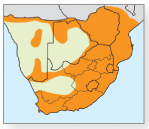

© W. MCILLERON

© F. DE MOOR

© W. MCILLERON
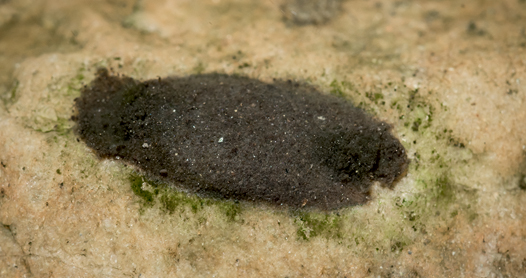
© W. MCILLERON
Adults small, silvery-grey to yellow-brown, with pale markings on wings as shown in this Ecnomus species (1). Tibial spur formula (2, 4, 4 or 3, 4, 4), characteristic warts on head and thorax and distinctive male genitalia are diagnostic. Larvae of genus Ecnomus (22 species) have three fully sclerotised thoracic plates and often have distinctive pigmented pattern on head capsule (1a); also lack abdominal gills. Larvae of the western and southern Cape endemic Parecnomina resima (1b) have only first thoracic segment sclerotised. Size: Adult wingspan 7–12mm; mature larvae 5–15mm in length. Biology: Larvae construct fixed, loosely woven, debris-covered, tubular shelters with an opening forming an extended fan-like net at either end (1c). Predaceous, feeding on other aquatic invertebrates, which they capture around their shelters. Depending on the species, they are found in slow- to swift-flowing water and also in backwaters and lakes.
2 Burrowing (Large-collared) caddisflies
Family Dipseudopsidae


© C. GRIFFITHS & M. PICKER

© F. DE MOOR

© F. DE MOOR
Adults (2) large, plain brown or grey with broad, pale first thoracic segment, resembling a collar. Tibial spur formula 2, 4, 4. Larvae with large rostral (beak-like) process at base of maxilla a distinctive feature of the three recorded species, shown here in Dipseudopsis capensis. Larvae (2a) long, with prominent thoracic and anal gills and extended, very long, anal prolegs; all legs have flattened tarsal segments with brushes of setae (2b). Size: Adult wingspan 25–30mm, larvae up to 40mm in length. Biology: Larvae construct Y-shaped, silk-lined, tubular burrows in fine sediments. Upper halves of tubes extend above surface of substrate: water is drawn in at one end of tube, then passed through a constructed sieve-net and out the other end. Larva undulates its abdomen, generating a current, and can manoeuvre itself to face either the inhalant or exhalent tube, by making use of the extended lower arm of the Y-shaped tube. Larvae are filter feeders, consuming fine particulate matter in standing water in small lakes or backwaters of rivers.
3 Net-tube caddisflies
Families Xiphocentronidae and Psychomyidae


© F. DE MOOR
Adults small, plain brown or grey, with mottled pale patches, similar to the adults of Ecnomidae. Tibial spur formula variable. Larvae small with only the pronotum sclerotised. The only xiphocentronid, Abaria electa, distinguished from the three known psychomyiid species by presence of a median (central) hardened strip on the middle section of thorax and by conical shape of foreleg basal extension (the pre-episternum), which is flat or hatchet-shaped in the psychomyiid genera Tinodes and Paduniella (both of which also lack the median sclerotised strip on the mesonotum). Size: Adult wingspan 5–9mm, larvae 5–6mm in length. Biology: Larvae of both families are specially adapted to living in the thin film of water flowing over the upper surfaces of stones or bedrock in streams. Larvae construct tubes of silk fixed to the rocks and covered with sand and organic debris; they extend these silk tubes slowly across the surface, enabling them to remain in the water flow, where they graze on algae growing on the stone surface. Net-tubes of Abaria electa (3) shown.
1 Armoured ballast case makers
Family Goeridae


© F. DE MOOR

© F. DE MOOR
Adults medium-sized, with pale brown wings and reddish thorax, long pale brown basal antennal joint, other segments dark; tibial spur formula 2, 4, 4. Mature larvae of the only species, Goera hageni, have large heavily sclerotised thoracic plates, which, with tucked-in head, combine to form an operculum (lid) sealing off opening of case and offering protection from predators. Size: Adult wingspan 12–14mm, larvae 6–7mm in length. Biology: Larvae (1) construct characteristic portable cases with large sand grains for ‘ballast’ on the sides of the front end, which help them to maintain purchase on substratum in flowing water. Pupal cases (1a) constructed in crevices between stones, usually in clusters, and also reveal diagnostic large ballast quartz grains around their front ends. Larvae graze on algae and organic detritus from stone surfaces.
2 Lepidostomatid square case makers
Family Lepidostomatidae


© F. DE MOOR

© F. DE MOOR
Adults medium-sized, with dark brown wings; underside of thorax and legs orange; long, dark brown basal antennal joint with very long setae and sparse scales; tibial spur formula 2, 4, 4 as in Lepidostoma caffrariae (2). Mature larvae characterised by a distinct pattern of sclerites (hardened plates) with setae, dorsally on middle part of thorax, as well as by rounded head. Size: Adult wingspan 12–15mm, larvae 6–8mm in length. Biology: Mature larvae use finely cut leaf fragments to construct portable cases that are square when viewed end-on; earlier instar larvae (2a) predominantly use sand grains, progressively adding bark and cut leaf litter to the front ends of their cases. The larvae are shredders and feed on detritus and leaf litter in forested streams. A second species of Lepidostoma, L. brachycerus, is known from Zimbabwe, and larvae of an undescribed species have been collected in Limpopo and Mpumalanga provinces.
3 Pisuliid triangular case makers
Family Pisuliidae


© F. DE MOOR

© W. MCILLERON

© F. DE MOOR
Adults, like Silvatares collyrifer depicted here (3), medium-sized to large, with rounded oval, mottled yellow-brown to dark brown wings; undersides of thorax and abdomen brown-orange, legs brown; tibial spur formula 2, 4, 4. Mature larvae characterised by single, median, D-shaped sclerite (hardened plate) on top of third thoracic segment. Size: Adult wingspan 20–40mm, mature larvae 15–22mm in length. Biology: Larvae use sections from dead leaves and twigs to construct portable cases that are triangular when viewed end-on (3a). Larvae of the two known genera (Silvatares and Pisulia) all have a characteristic ’prosternal horn’ (3b), which is also diagnostic for the families Goeridae and Lepidostomatidae (see 1 and 2, above). Larvae are shredders of leaves in forested streams. Four species of Silvatares and two of Pisulia known from southern Africa.
1 Long-horned caddisflies
Family Leptoceridae

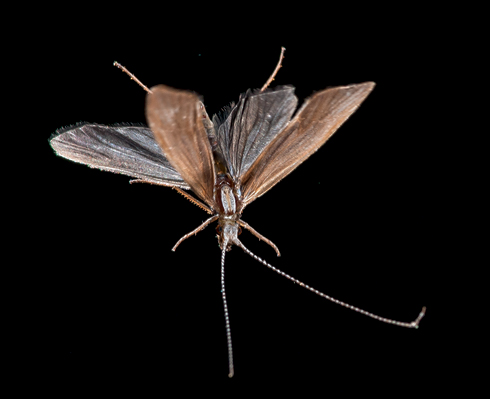
© F. DE MOOR / W. MCILLERON

© F. DE MOOR / W. MCILLERON

© F. DE MOOR / W. MCILLERON
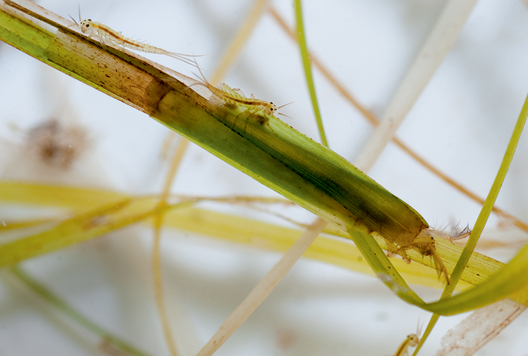
© F. DE MOOR / W. MCILLERON

© F. DE MOOR / W. MCILLERON

© F. DE MOOR / W. MCILLERON

© F. DE MOOR / W. MCILLERON

© F. DE MOOR / W. MCILLERON

© F. DE MOOR / W. MCILLERON
Adults small to large, usually slender, with plain to mottled grey, brown or ochre-yellow wings, often with markings, and in some instances with sparsely scattered scales. Thorax has diagnostic pattern comprising two irregular lines of setae (fine hairs) from front to back, as in Athripsodes schoenobates (1); antennae very long, 2–3 times length of the forewing; tibial spur formula 0, 2, 2 or 1, 2, 2 or 2, 2, 2. Larvae distinguished from those of other families by a combination of characteristics: the antennae can, in most instances, be seen under a compound microscope or with a hand lens (in most other caddisfly families larval antennae not visible); head shape is usually elongated; hindlegs can be modified for swimming; pro-and mesothorax bear two well-sclerotised dorsal plates, and abdomen has dorsal and lateral abdominal humps that help to anchor larvae in their portable cases. Size: Adult wingspan 10–40mm, mature larvae 5–20mm in length. Biology: Adults attracted to light in large numbers, and males often form mating swarms that fly in zig-zag fashion over water surfaces. Larvae of all species construct portable cases – the greatest variation in case structure is seen in this family. Cases may be made of pure silk, sand grains or carefully cut sections of sedge or other plant matter. Even within a species, differences in case structure between different developmental stages are considerable. Larvae of A. schoenobates (1a), A. prionii (1b) and Leptecho scirpii (1c) construct cases from live vegetation and have double fringes of setae on their elongated hindlegs to assist with swimming. A. bergensis (1d), an abundant species in southern Cape rivers, constructs cases (1e) from sand grains and also frequently uses and modifies abandoned cases of other species, such as those of Barbarochton brunneum, by adding a sand-grain hood (1f) to the case opening. L. helicotheca (1g) constructs a snail shell-shaped sand-grain case. Most species of Oecetis (1h) are predators. Feeding specialisations in other species in the family include shredders and detritivores. Athripsodes (32 described species) is the most speciose genus. Twelve genera and 86 species of Leptoceridae are recorded in southern Africa, and recent surveys have recorded many additional undescribed species.
2 Barbarian tusk case makers
Family Barbarochthonidae


© F. DE MOOR / W. MCILLERON
Adults small to medium-sized with dark sepia-brown head and thorax and pale brown wings; antennae as long as the forewing, tibial spur formula 2, 2, 4. Larvae with a diagnostic round, blackish-brown, honeycomb-patterned head with ridge around upper side that helps seal opening of the case when retracted. Eyes surrounded by clear pale area. Size: Adult wingspan 11–15mm, mature larvae up to 8mm in length. Biology: Mature larvae of the only species, Barbarochthon brunneum (2), construct cylindrical, slightly curved, portable cases of silk, sparsely adorned with very fine sand grains. Found in clear acidic mountain streams in western and southern Cape, where they are known to feed on aquatic moss and Scirpus digitatus.
1 Snail case-making caddisflies
Family Helicopsychidae


© F. DE MOOR
Adults small with dark brown body and wings, antennae with long curved basal segment, as long as forewing, tibial spur formula 2, 2, 4. Larvae small and distinguished from Leptecho helicotheca (see p.236, 1g) by more rounded head and lack of visible antennae. Size: Adult wingspan 9–10mm, larvae 5mm in length. Biology: Mature larvae of all species in genus Helicopsyche make diagnostic snail shell-shaped cases (1) of very neatly arranged, nearly uniformly sized, sand grains. One undescribed species recorded from streams in the Chimanimani Mountains, Zimbabwe.
2 Golden tusk case makers
Family Hydrosalpingidae


© F. DE MOOR
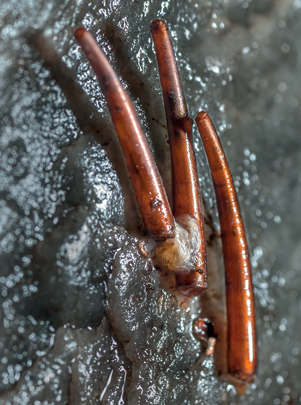
© F. DE MOOR
Adults medium-sized, with reddish-brown body and yellow-brown underside and legs; wings densely hairy and golden brown with dark front margin; antennae longer than forewing; very long palps (4–5mm) extending from mouthparts, tibial spur formula 2, 2, 4. Larvae recognised by lack of visible antennae, as well as by their unusual cases. Size: Adult wingspan 20–28mm, mature larvae 17–18mm in length. Biology: Mature larvae of only known species, Hydrosalpinx sericea (2), construct beautiful, tusk-shaped, golden-brown cases out of pure silk. Opening of the case slightly flared and thickened. Larvae congregate to form pupae (2a) in their larval cases. The larval and pupal cases are often used by leptocerid larvae, and care must be taken to identify the species inside the cases. Larvae often associated with leaf litter in high-lying, swift-flowing, cold, acidic mountain streams in the Western Cape, where they feed on detritus and epiphytic growth.
3 Limpet shell case-making caddisflies
Family Petrothrincidae


© C. GRIFFITHS & M. PICKER

© W. MCILLERON

© W. MCILLERON
Adults, like Petrothrincus circularis (3) shown, small to medium-sized, with dark brown head and thorax and grey-brown wings with silvery white patches; abdomen reddish orange on underside, tibial spur formula 2, 2, 4. All three species of Petrothrincus have notably long fringes of setae on hindwings. Larvae characteristically dorsoventrally flattened. Size: Adult wingspan 11–18mm, mature larvae 6–8mm in length. Biology: Larvae construct diagnostic, neat, limpet-shaped cases (3a) of fine sand grains – P. demoori (3b) depicted. Found on large boulders in backwater pools of swift-flowing mountain streams in western and southern Cape, where they feed on diatoms and periphytic growth on stones.
4 Brushtailed case-making caddisflies
Family Sericostomatidae


© F. DE MOOR

© F. DE MOOR

© W. MCILLERON
Adults small to large, with light to dark brown head, thorax and wings, abdomen yellow-orange, wings covered with short grey or golden pubescence (4). Tibial spur formula 2, 2, 4 and spines are visible on tibiae. Larvae all recognised by having square to rounded dark brown heads with no visible antennae and sharply pointed margin on each front end of anterior thoracic plate (pronotum). Rhoizema montanum (4a, 4b) is one of the larger species. Size: Adult wingspans 11–35mm, mature larvae 5–20mm in length. Biology: Larvae construct neat, tubular, slightly curved cases of fairly uniformly sized sand grains, often burrow in fine sandy sediments and are presumed to feed on detritus. Adult males often have scent glands on antennae and females are located through scents that they emit. Five genera: Aclosma, Aselas, Cheimacheramus, Petroplax and Rhoizema, with 12 species recorded from southern Africa. All except two species of Aclosma endemic to western and southern Cape.